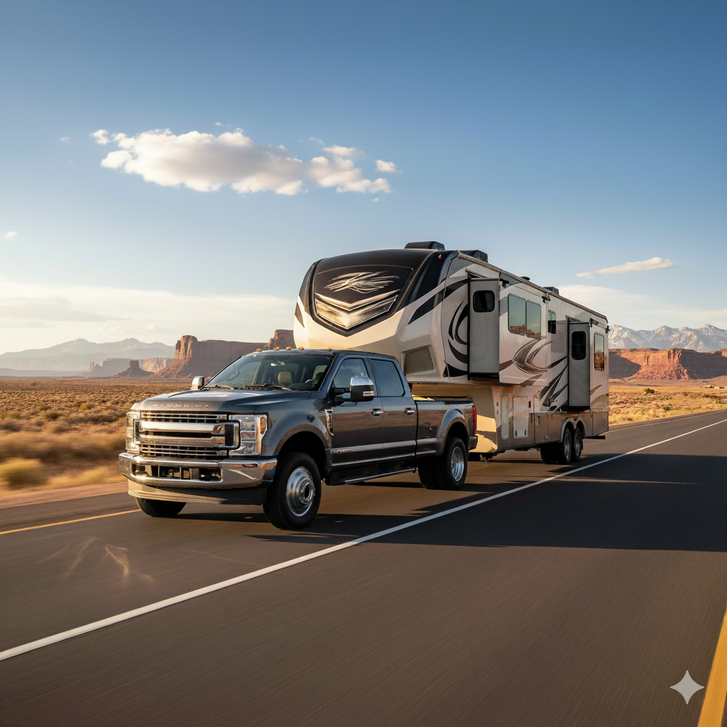How to Choose the Right Fifth-Wheel Hitch for Your Truck & Trailer
So, you've got got your truck and your fifth-wheel trailer. The open road is calling, but there’s one important piece of the puzzle you need to get right, the hitch.
Choosing the right fifth-wheel hitch isn't a decision to take lightly. It’s the heart of your towing system, the connection that ensures your journey is safe, secure, and stress-free. With so many options on the market, it can feel a little overwhelming. But don't worry, we're here to break it down for you.
This guide will walk you through everything you need to know to find the perfect fifth-wheel hitch for your specific truck and trailer combination.
The Big Picture: Why the Right Hitch Matters
Think of your hitch as the handshake between your truck and your trailer. A bad handshake can lead to a lot of problems, from a rough ride to, in the worst cases, catastrophic failure. The right hitch ensures a smooth, stable, and predictable towing experience. It protects your truck’s frame, prevents damage to your trailer, and, most importantly, keeps you and your family safe.
Step 1: Know Your Numbers – A Tale of Two Weights
Before you even start looking at hitch models, you need to understand two important numbers, your truck's towing capacity and your trailer's weight.
-
Gross Trailer Weight (GTW): This is the total weight of your fully loaded trailer. Check the sticker on your RV; it will list the GVWR (Gross Vehicle Weight Rating). Always use this number, as it accounts for the trailer's total loaded weight.
-
Pin Weight (or Pin Box Weight): This is the downward force the trailer's king pin exerts on the hitch in your truck bed. It's usually about 15–25% of the GTW. Your hitch’s Vertical Load Limit must be higher than this number.
Your hitch’s weight rating must be greater than your trailer's GTW and pin weight. Don't just meet the number, exceed it. A little extra capacity is a safety net you'll be glad to have.
Step 2: Truck Bed Length - Short, Long, or somewhere in between?
This is a major factor in your hitch decision.
-
Long Bed (8 ft): If you have a long bed truck, you're in luck! You can use almost any standard fifth-wheel hitch. You won't have to worry about the trailer hitting the cab during tight turns.
-
Short Bed (5.5–6.5 ft): Short bed trucks are popular for daily driving, but they pose a challenge for fifth-wheel towing. Without a special hitch, the corner of your trailer can make contact with the back of your truck's cab during sharp turns. This is where specialized slider hitches come in.
Step 3: Understanding Your Hitch Options
Now that you have your numbers and know your truck's bed length, it's time to explore the different types of hitches.
Standard Fixed-Head Hitch
-
Who it's for: Long bed truck owners.
-
Pros: Generally the most affordable option, robust, and reliable.
-
Cons: Not suitable for short bed trucks due to the risk of cab damage.
Sliding or "Slider" Hitch
-
Who it's for: Short bed truck owners.
-
How it works: This type of hitch is mounted on rails that allow it to slide back, creating extra clearance between the trailer and the cab when you need to make a tight turn (like backing up or maneuvering in a campground). You lock it back into the normal towing position once you're on the open road.
-
Pros: Solves the short bed turning problem, offering peace of mind.
-
Cons: More expensive and heavier than a fixed hitch. Can be a bit cumbersome to use.
Gooseneck-to-Fifth-Wheel Adapter
-
Who it's for: Truck owners who primarily use a gooseneck hitch but occasionally need to tow a fifth wheel.
-
How it works: This adapter fits into your truck's gooseneck ball, providing a standard fifth-wheel king pin receiver. The B&W Companion Hitch is a prime example of this type.
-
Pros: Versatility, uses the existing gooseneck hitch hardware.
-
Cons: Not a true fifth-wheel hitch, can put different stresses on the trailer's frame, and may void some trailer warranties. Check with your trailer manufacturer first!
Step 4: Installation and Mounting
There are two primary ways a fifth-wheel hitch can be mounted in your truck bed.
-
Rail Mount System: This is the traditional and most common method. Rails are bolted to the truck's frame, and the hitch is then bolted to the rails. This allows for easy removal of the hitch when you need to use the full truck bed.
-
Underbed or Puck System: This is a cleaner, more modern option, often found on newer trucks from manufacturers like Ford, Ram, and GM. The mounting hardware is hidden under the truck bed, and the hitch drops directly into the "pucks" or receivers in the bed floor. This leaves the bed completely clear when the hitch is removed.
Step 5: The Final Considerations
-
Head Articulation: Look for a hitch with a head that can pivot or "articulate." This allows the hitch to move with the truck and trailer over uneven terrain, preventing a harsh, jarring ride.
-
Jaw System: The jaw is what secures the king pin. A single wrap-around jaw (like on many Curt hitches) provides a 360-degree contact, creating a tighter, more secure connection and a smoother ride with less chucking (fore-and-aft movement).
-
Brand Reputation: Stick with reputable brands known for quality and safety. Curt, B&W, and Reese Hitches are all well-regarded names in the industry.
Choosing the right fifth-wheel hitch is about matching your specific needs with the right equipment. By understanding your weights, truck bed length, and the different types of hitches available, you can make a confident decision that will lead to countless safe and enjoyable adventures on the road. Now go hit the open road and tow with confidence!

